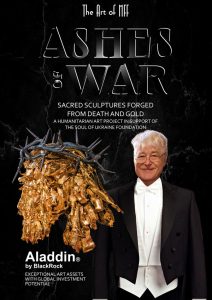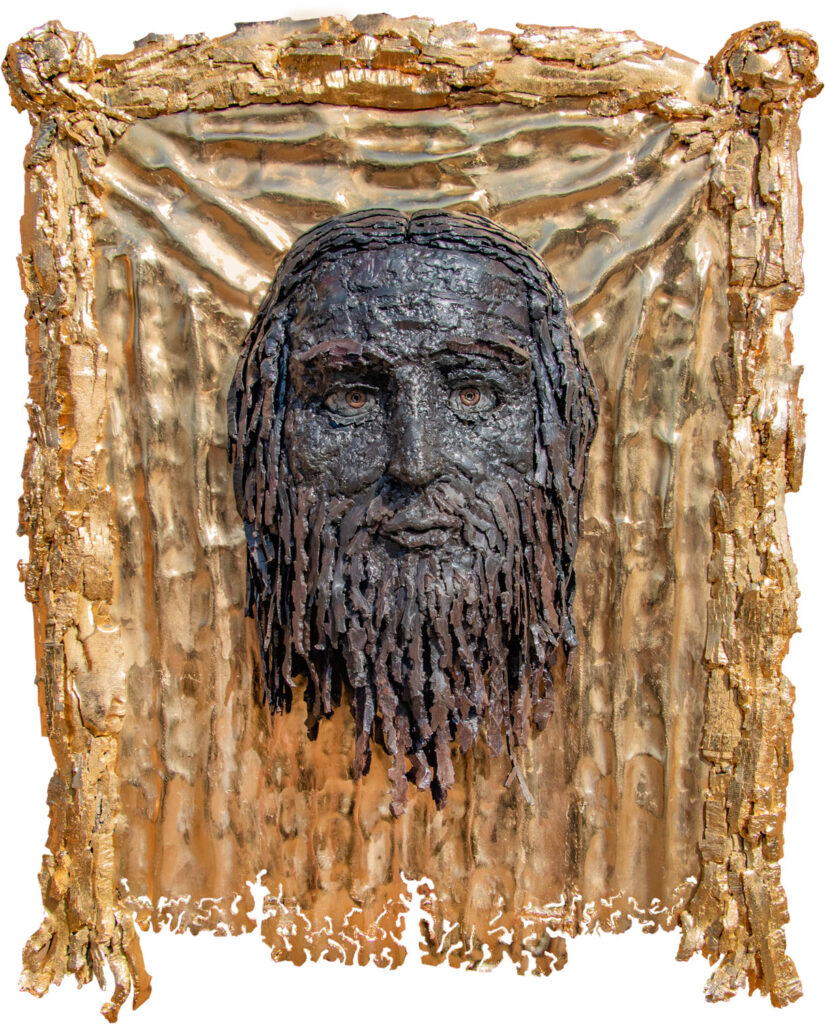
Details
THE HOLY MANDYLION
The sculpture’s elements are forged from the “ashes of war”—fragments of artillery shells and mortars. The sacred veil with which Christ is believed to have wiped His face on the way to the crucifixion is recreated from 30mm automatic cannon casings, gilded with 999.9 fine gold.
Dimensions: 73 х 60 х 18 cm | 28⅞ x 23⅗ x 7⅒ in
Gross Weight: ~35 kg
Provenance
The Author: Sergey Melnikoff (MFF) in collaboration with Ukrainian welder Victor Bielchyk.
This work of art was created in Odesa, Ukraine, in 2025, during a critical phase of the Russian-Ukrainian war.
Owner and Seller: The Soul of Ukraine Foundation, Inc. — a U.S.-based charitable public corporation registered under section 501(c)(3) of the Internal Revenue Code.
A 501(c)(3) tax-deductibility certificate is issued to the purchaser, allowing the full amount expended to be written off for U.S. federal tax purposes.
Further Details
The Ukrainian Review: — With a gift for forging profound artistic masterpieces from the very ashes of war, Sergey Melnikoff has carved out an unshakable claim to be the foremost visionary in this realm. His works do not merely reflect conflict—they transcend it, transforming devastation into enduring symbols of spirit and hope.
— You are a genius, turning fragments that took lives into a great Resurrection!
— Ludmila Leukhina
Art Beauty Industry Biotech, Kharkiv
The Holy Mandylion
A Sacred Transmutation of War Metal in the Age of Post-Secular Art
By Georg L. Baker
In the heart of 21st-century conflict, a work of sacred art has emerged that defies categorization. The Holy Mandylion, a sculptural icon created by American artist Sergey Melnikoff, a.k.a. MFF, in collaboration with Ukrainian metalworker Viktor Bielchyk, is more than a tribute to faith — it is a spiritual alchemy forged from the very debris of war.
Constructed from actual shrapnel gathered from artillery shells and mortar explosions, the sculpture reimagines the canonical face of Christ as a relic born not from peace, but from destruction. It is a haunting response to the ongoing war in Ukraine — and a testament to the enduring dialogue between violence and transcendence, memory and transformation.
Reclaiming the Sacred in Contemporary Art
In an era where contemporary art often drifts toward irony, simulation, and digital abstraction, The Holy Mandylion arrives as a sincere and startling anomaly. It speaks in the language of relics and redemption, sacrifice and salvation — themes increasingly resurfacing in post-traumatic, post-digital, and post-secular contexts.
Melnikoff’s work does not merely gesture toward the sacred; it inhabits it. Unlike postmodern reinterpretations that play with symbols from a distance, this sculpture draws the viewer into a deeply metaphysical experience. It serves as a bridge — a raw and tangible mediator — between the annihilating matter of modern warfare and the timeless archetypes of religious tradition.
Matter Transformed: From Shrapnel to Grace
The physical composition of the sculpture is as symbolic as it is literal. Fragments of bombs, cast in iron — a notoriously unforgiving and difficult material — are assembled piece by piece to form the anguished face of Christ. None of these elements have been altered or reshaped; they are used as found, preserving the violence etched into their form.
This process becomes an act of artistic transubstantiation: weapons of death reimagined as vessels of grace. The very impossibility of the material becomes a metaphor for spiritual resistance. Melnikoff does not impose his will upon the iron; instead, he engages in a silent negotiation with it, allowing its scars to remain visible, even honored.
This respectful yet defiant approach places the work within a lineage of artistic mastery — reminiscent not of industrial design, but of Renaissance sculpture, where every gesture, every curve, is guided by both vision and reverence.
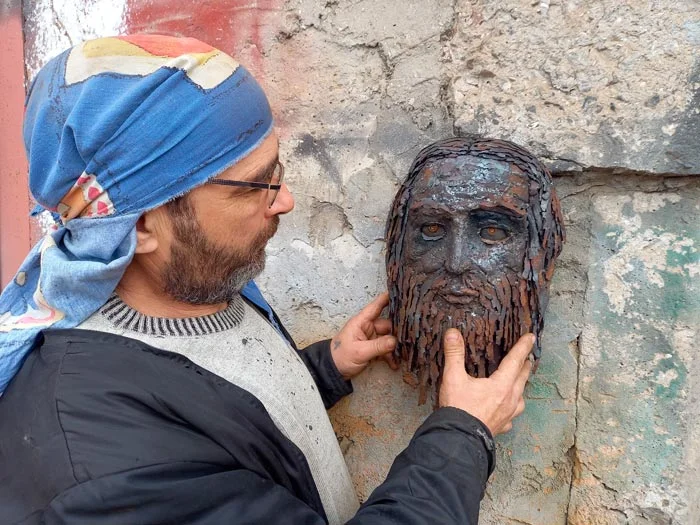
The Art of MFF | Victor Bielchyk examines the central element of The Holy Mandylion sculpture.
May 27, 2005. Odesa, Ukraine
Photo by MFF
Reinventing the Acheiropoietons
The iconographic reference is unmistakable. The Holy Mandylion directly alludes to the acheiropoietons — the “image not made by human hands,” a miraculous imprint of Christ’s face central to Byzantine devotion. Yet here lies Melnikoff’s radical gesture: he reproduces the “uncreated” through the most human of acts — sculpting, welding, assembling.
In doing so, he does not undermine the sacred narrative but rather renews it. In a world where the boundaries between religion, art, and ideology are increasingly blurred, this reimagined acheiropoietons challenges viewers to consider where divinity might still reside.
The sculpture’s aesthetic — unpolished, rusted, fractured, and punctuated with gold-plated bullet casings — speaks in the harsh dialect of the present. And yet, its silent gaze reaches beyond time, into the eternal.
A Relic for a Wounded Age
The Holy Mandylion is not content to sit behind museum glass. It exists as a living relic — a work that absorbs the functions of prayer, memorial, witness. In secular spaces, it creates a sacred zone. Its presence invites not just observation but participation — emotional, ethical, and perhaps even spiritual.
The shimmering gold of Veronica’s veil contrasts with the almost-charred visage of Christ, provoking not merely aesthetic admiration, but inner reckoning. The effect is profoundly cathartic. It offers no easy comfort, but instead a confrontation: with suffering, with endurance, with the possibility of hope.
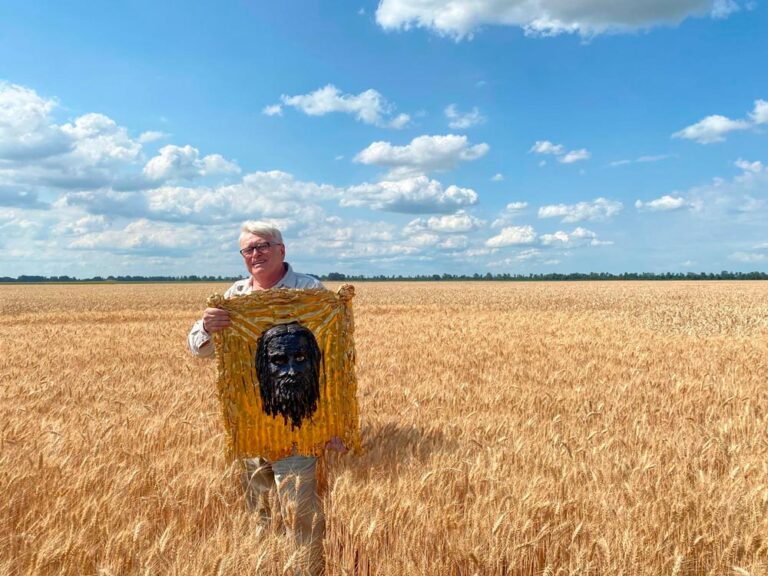
The Art of MFF | Sergey Melnikoff with the iron icon The Holy Mandylion, standing in a golden wheat field in Ukraine.
Photo by Anastassia Melnikov
Conclusion: A Liturgy of Metal and Memory
In a time when visual culture is increasingly dominated by distraction and spectacle, The Holy Mandylion reasserts the possibility of the sacred in art. It doesn’t preach. It transforms.
It asks: Can the sacred still speak — even now, even here — without the trappings of institutional religion?
Its answer is forged in fire and silence. And it is yes.
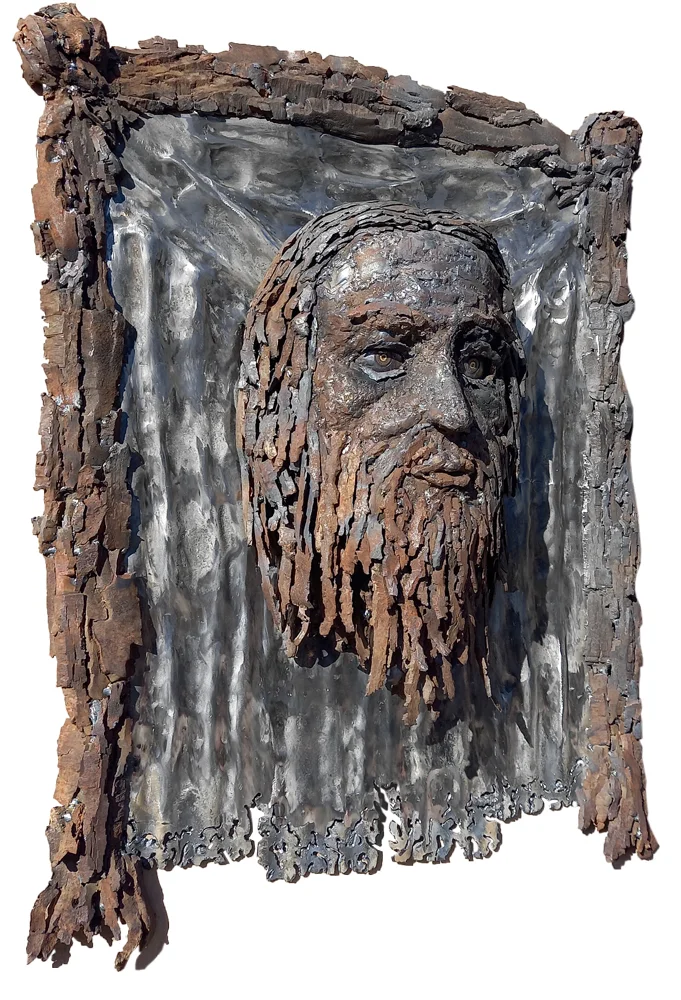
The Art of MFF | The Holy Mandylion sculpture, shown prior to the application of gold plating to the metal ‘towel’ background. Estimate: USD 900,000 — 1,200,000
The Holy Mandylion
Estimate
USD 900,000 — 1,200,000
Exclusive First-Sale Price:
USD 350,000
Offered at a special inaugural price, this one-of-a-kind sculpture is crafted from real military ammunition fragments coated in pure gold—a rare opportunity for discerning collectors, museums, and art dealers to acquire a historic masterpiece.
The Holy Mandylion is more than a symbolic representation of faith, the work constitutes a form of spiritual transformation—an artistic transmutation of war debris into a sacred object.
The sculpture is constructed from fragments of artillery shells and mortars, which are electro-welded into a unified composition without altering their original forms. This technique preserves the authenticity of the materials, emphasizing their provenance from zones of conflict. Central to the composition is a representation of the Mandylion, the veil believed in Christian tradition to have borne the image of Christ’s face during His procession to the crucifixion. In this artwork, the veil is fashioned from 30mm automatic cannon casings and gilded with 999.9 fine gold, symbolically reconciling instruments of destruction with an icon of peace and divinity.
In Christian theology, the Acheiropoietos—a term derived from ancient Greek, meaning “not made by human hands”—refers to miraculous images of Christ’s face believed to have appeared on cloth without human intervention. Melnikoff’s interpretation does not seek to replicate this miracle but rather to contextualize it within a contemporary framework. The sculpture serves as both an artifact and a testimony: a spiritual document reflecting the existential tensions of the present era.
In contrast to much of contemporary art, which often eschews metaphysical or transcendent concerns, The Holy Mandylion reasserts the traditional function of sacred art as a conduit between the human and the divine. It does not oppose tradition but rather extends and rearticulates it within the conditions of modernity. As such, it may be understood as a paradigmatic instance of what future generations might regard as a return to enduring artistic and spiritual values.
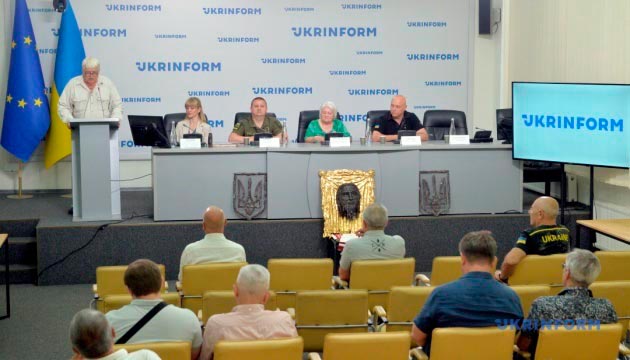
A press conference at the Ukrainian National News Agency “Ukrinform” in Kyiv on July 10, 2025, featured the public unveiling of the iron icon The Holy Mandylion to the media. In recognition of their outstanding contributions to art and their support during the war, Sergey Melnikoff and Viktor Bielchyk were awarded the “For Cooperation” medals by the State Border Guard Service of Ukraine.
The high departmental award was presented to the American artist on behalf of the State Border Guard Service by Colonel Dmytro Tukalo, Head of the Military Chaplaincy Service.
Organizers:
The Ukrainian National News Agency Ukrinform,
The State Border Guard Service of Ukraine,
The Military Chaplaincy Service of Ukraine,
The International Charitable Foundation Soul of Ukraine,
The Charitable Foundation for Disabled Persons and Combatants Pride UA,
The American nonprofit public charity The Soul of Ukraine Foundation, Inc.
In Ukraine, an icon of Christ the Savior was created from the fragments of mines and shells.
ChatGPT:
Currently, the market value of MFF’s works from the Ashes of War series is estimated by experts to range from $150,000 to $1,000,000, depending on the size, materials used, symbolic impact, and associated narrative.
It is widely expected that following the end of the war and the cementing of these works’ historical importance, their value will rise exponentially, especially among collectors, investors, and museums worldwide.
History of the Iron Icon
On July 9, 2025, in a modest rural church of the Ukrainian Orthodox Church in the village of Borodianka near Kyiv—painstakingly restored after being destroyed by Russian forces—a sacred ceremony was held to consecrate The Holy Mandylion. Three military chaplains of the State Border Guard Service of Ukraine—Andriy Yaniv, Yurii Parfaniuk, and Roman Khorbutii—officiated the service. According to Orthodox tradition, this “iron icon” thus became a holy relic, sanctified by the pain and resilience of war-torn Ukraine.
A Photo Gallery
Borodianka, a small town 50 kilometers from Kyiv, was founded in 1190 and first mentioned in chronicles that same year. However, in 2022, its name became symbolic of the brutality of Russia’s invasion of Ukraine. From February 25 to April 1, the town was under Russian occupation and witnessed some of the war’s fiercest fighting.
On March 1–2, targeted Russian airstrikes leveled residential high-rises in the town center, killing over 300 civilians. Many were entombed alive in the basements beneath the rubble. Russian forces forbade locals from clearing the debris to rescue the trapped, and for several harrowing days, cries for help echoed from beneath the ruins.
Atop the rubble of one of these buildings, the same three chaplains—Andriy Yaniv, Yurii Parfaniuk, and Roman Khorbutii—joined by war-disabled veterans, offered a prayer for the souls of those who had perished in such unspeakable horror.
Photos by MFF & Anastassia Melnikov
A Photo Gallery
Brought to you by
Related Videos
The Art of MFF | A short video capturing the first steps in the creation of the sculpture The Holy Mandylion by Sergey Melnikoff, a.k.a. MFF
A Photo Gallery
The Making of The Holy Mandylion
Related articles
✦ Homin Ukrainy (The Voice of Ukraine) | In Ukraine, an icon of Christ the Savior was created from the fragments of mines and shells
✦ Ukrinform | В Україні з уламків мін і снарядів створили ікону “Спас Нерукотворний”
✦ Ukrinform | Презентація творів з “попелу війни”
✦ The Ukrainian Review | MFF: Finding Hope in Art Amidst Dark Realities
✦ More Liudei | Безмовне воззвання Янгола
✦ Національна бібліотека України ім. Ярослава Мудрого | В Україні з уламків мін і снарядів створили ікону. “Спас Нерукотворний” (pdf)
✦ Il Popolo (ital) | Per l’amore dell’umanità
✦ Worldphoto.us | Αχειροποίητος
✦ Rubryka | “Спас Нерукотворний” в Україні
✦ UA факти | В Україні з уламків мін і снарядів створили ікону “Спас Нерукотворний”
✦ DIM.TV | “Спас Нерукотворний”: американський митець показав ікону, створену з уламків артилерійських мін і снарядів
✦ NUO | В Україні з уламків мін і снарядів створили ікону “Спас Нерукотворний”
✦ Day Kyiv | В Україні з уламків мін та снарядів створили залізну ікону
✦ Raskolam.net | В Україні з уламків боєприпасів створили ікону “Спас Нерукотворний”
✦ Donbas Patriot | З уламків мін і снарядів в Україні створили ікону “Спас Нерукотворний”
✦ Ceske Noviny | В Україні з уламків мін і снарядів створили ікону “Спас Нерукотворний”
✦ UA ZMI | З уламків мін і снарядів в Україні створили ікону “Спас Нерукотворний”
✦ U Psihologa | В Україні з уламків мін і снарядів створили ікону “Спас Нерукотворний”
✦ My News | В Україні з уламків мін і снарядів створили ікону “Спас Нерукотворний”
✦ Ua Fakty | В Україні з уламків мін і снарядів створили ікону “Спас Нерукотворний”
✦ Твої новини | В Україні з уламків мін і снарядів створили ікону “Спас Нерукотворний”
✦ Спілка православних журналістів | В Україні спорудили “Спаса Нерукотворного” з уламків мін і снарядів
✦ Veda | В Україні з уламків мін і снарядів створили ікону “Спас Нерукотворний”




